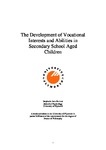The Development of Vocational Interests and Abilities in Secondary School Aged Children
| dc.contributor.supervisor | Handley, Simon | |
| dc.contributor.author | Bennett, Stephanie Jane | |
| dc.contributor.other | Faculty of Science and Engineering | en_US |
| dc.date.accessioned | 2012-12-12T15:54:24Z | |
| dc.date.available | 2012-12-12T15:54:24Z | |
| dc.date.issued | 2012 | |
| dc.identifier | 748628 | en_US |
| dc.identifier.uri | http://hdl.handle.net/10026.1/1232 | |
| dc.description.abstract |
This body of work has focussed on the measurement, structure and stability of vocational interests and abilities in mainstream, mixed-ability secondary school aged children. This set of studies investigated how a large group of children’s vocational interests developed over a two year period, and how their interests for activities/occupations were related to selected abilities (Mechanical, Spatial Rotation and Logical Reasoning). Published research has consistently demonstrated that for adults, vocational interests are stable over time, and that interests typically fall into six main categories; Realistic, Investigative, Artistic, Social, Enterprising and Conventional (Holland, 1959). Furthermore, there is a wealth of evidence to suggest that the relationships between these six categories broadly approximate a hexagonal framework once individuals reach adulthood (e.g. Holland et al., 1969). Data analysis revealed that similar to adults, children’s interests overall were remarkably stable over time, and that this was particularly the case for Realistic and Social interests. The findings were also suggestive of a pathway of interest development in children aged 11-17. The youngest children who participated in this research had interests that were often gender stereotyped, though the structure of their interests was not consistent with the hexagonal structure commonly seen in adults. However, as children got older, their interests became more aligned to a hexagonal format, particularly for the female group. Furthermore, there were clear gender differences with females typically having more distinctive and more consistent interest profiles over time. There were a few weak associations between ability and interest, with the clearest link suggesting that early Realistic interests are predictive (in part) of later Mechanical ability. These findings consequently have practical implications for the timing and delivery of careers counselling in school. Theoretical implications and future directions have also been identified and discussed. | en_US |
| dc.description.sponsorship | E.S.R.C. & Learning and Skill Council | en_US |
| dc.language.iso | en | en_US |
| dc.publisher | University of Plymouth | en_US |
| dc.subject | Psychology | en_US |
| dc.subject | Development | en_US |
| dc.subject | Vocational Interests | en_US |
| dc.title | The Development of Vocational Interests and Abilities in Secondary School Aged Children | en_US |
| dc.type | Thesis | |
| plymouth.version | Full version | en_US |
| dc.identifier.doi | http://dx.doi.org/10.24382/3508 |
Files in this item
This item appears in the following Collection(s)
-
01 Research Theses Main Collection
Research Theses Main


